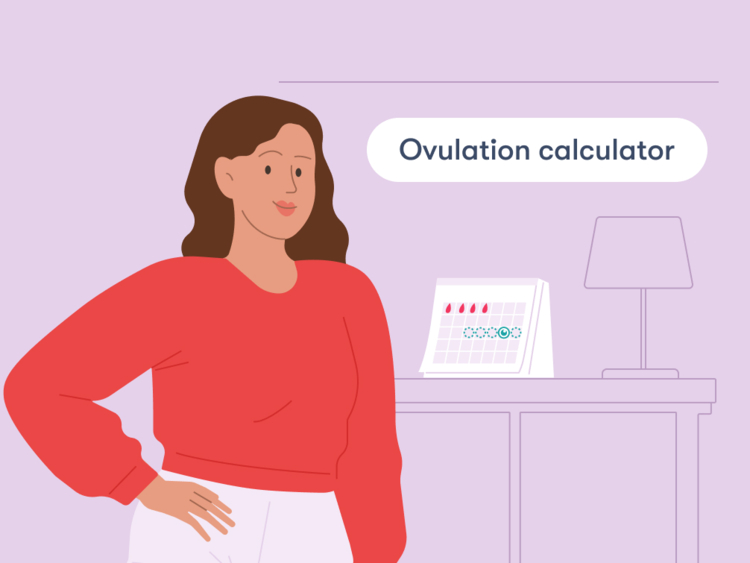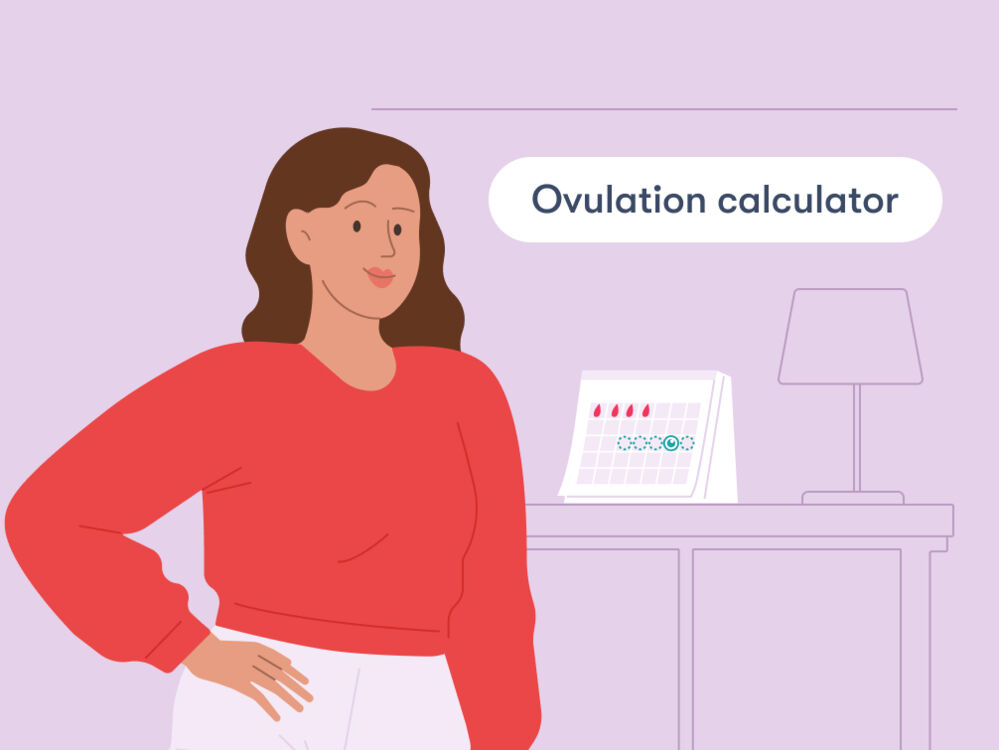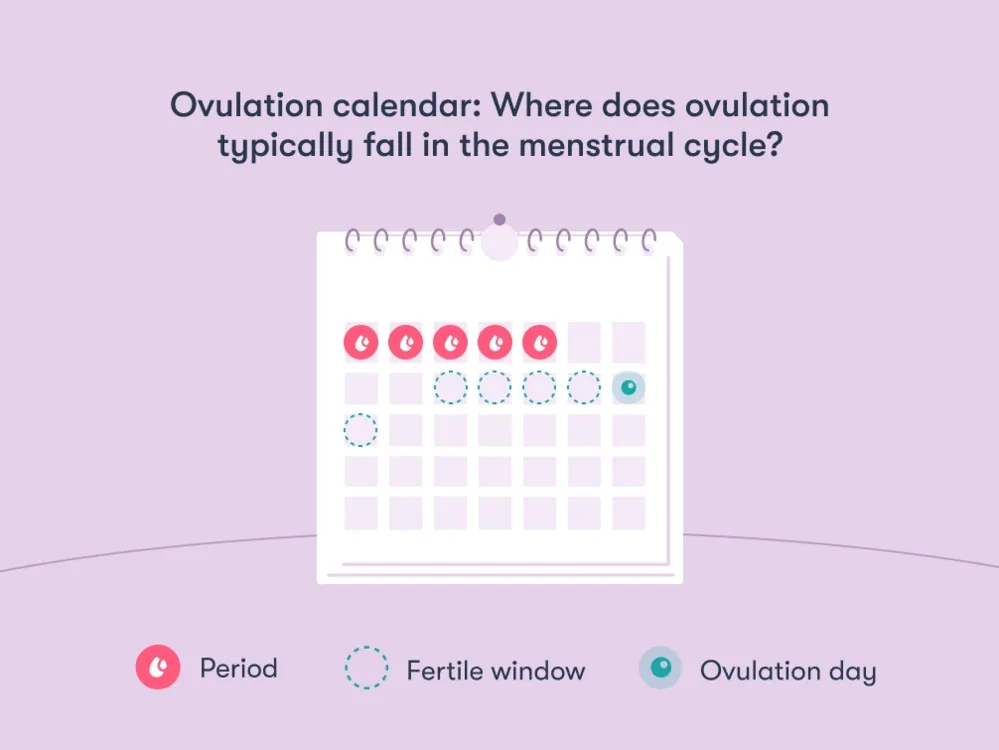-
Your cycle
-
Health 360°
-
Getting pregnant
-
Pregnancy
-
Being a mom
-
LGBTQ+
-
Quizzes
-
Ovulation calculator
-
hCG calculator
-
Pregnancy test calculator
-
Period calculator
-
Implantation calculator
-
Pregnancy calculator
-
Pregnancy due date calculator
-
IVF and FET due date calculator
-
Due date by ultrasound calculator
-
Medical Affairs
-
Science & Research
-
Pass It On Project New
-
Privacy Portal
-
Press Center
-
Careers
-
Contact Us
Ovulation calculator: Figure out your most fertile days
Knowing when you’re ovulating helps you work out when you could get pregnant. Discover when your fertile window is with Flo’s easy-to-use ovulation calculator.


We don’t collect, process, or store any of the data that you enter while using this tool. All calculations are done exclusively in your browser, and we don’t have access to the results. All data will be permanently erased after leaving or closing the page.
Learn more with Flo!

If you’re trying to get pregnant, it pays to know when you’re ovulating.
We only have a small fertile window each month during which we can conceive. But, by using some basic information about your cycle, Flo’s ovulation calculator can predict when your ovulation day is, so you know your most fertile days.
Try using our ovulation tracker now (above) and then scroll down for everything you need to know about ovulation, your fertile window, and how you can increase your chances of getting pregnant.
Remember that ovulation predictors, ovulation calendars, and fertility calculators can help you learn more about your most fertile days. But they are for informational purposes only and cannot and should not be used to prevent pregnancy. Menstrual periods are different from person to person and month to month. Results are estimates, and actual ovulation will vary for each woman.
Fertility cycle: What is ovulation?
If you’ve landed on this ovulation calculator, you might already be familiar with what ovulation is. But if you’re still a bit confused, let’s break it down with the help of Dr. Jennifer Boyle, obstetrician and gynecologist (OB-GYN) at Massachusetts General Hospital.
“Ovulation is when an oocyte, commonly called an egg, is released from the ovary,” Dr. Boyle says, adding that ovulation is necessary for a woman to become pregnant — and there's usually a 24-hour window when the egg can be fertilized by the sperm. For more info, take a look at our implantation calculator to find out when your pregnancy officially began.
But here’s another fun fact: “It’s also ovulation that causes a woman to have a period two weeks later if she doesn’t become pregnant.” This is because the ovaries signal a spike in progesterone right after ovulation, but if there’s no fertilized egg, those hormone levels start to decrease, and the body sheds the egg along with the lining of the uterus via a period.
Ovulation date: How is ovulation calculated? How many days after my period do I ovulate?
So now that we know what it is, how many days after your period can you expect to ovulate? Well, the complicated thing is that everyone is different — but usually, you can tell when you will ovulate by the length of your cycle.
The first day of your cycle is the first day of your period, and typically, most people will ovulate anywhere from 7 to 21 days into their cycle. Where exactly ovulation falls within that bracket depends on how long your cycle is. “Normal menstrual cycles can range from every 21 days to every 35 days,” says Dr. Boyle. “The time from ovulation to the next menstrual bleed will always be about 14 days — that’s generally the same for all women. But the time from the beginning of a period until ovulation is what can vary.”

How many days after your period can you get pregnant?
Here’s what that means in practice: “For women with cycles of 21 days, this means they ovulate [and can get pregnant] on day 7. If cycles are 28 days, then ovulation usually happens on day 14. For 35-day cycles, ovulation will be on day 21,” explains Dr. Boyle.
Ovulation chart: What is a fertile window? Can I get pregnant a few days after ovulation?
It’s especially important to track ovulation if you want to get pregnant because that gives you a firm idea of your fertile window. But … what actually is a fertile window?
Remember, it’s not possible to conceive throughout your whole cycle, so the fertile window is the small window of time where you could potentially get pregnant. “The fertile window is generally considered to be the 5 days before ovulation and the day of ovulation. This is because sperm can live in a woman’s body for up to 5 days,” says Dr. Boyle. “By contrast, the egg only survives or is viable and able to be fertilized for about 24 hours after ovulation. Studies show that the chance of pregnancy is highest when couples have sex 1 to 2 days before ovulation.”
So, if you’ve ever wondered if you can get pregnant a few days after ovulation, the answer is no. Because the egg only lasts for up to a day after it’s released, there would be nothing for the sperm to fertilize if you had unprotected sex in the days after you ovulated. That’s why it’s so key to know when you’re ovulating, and using an ovulation calculator is a really good way to predict this.
In order to confirm a prediction, you could use ovulation tests. They measure levels of a hormone called LH (luteinizing hormone) in your urine, as this surges right before you ovulate. Clever, right?
Want to know when you should take an ovulation test after your period? Dr. Boyle says the surge in LH happens on average around 36 hours before ovulation, so start testing two or three days before the ovulation calculator says you’re likely to ovulate.
What are the signs of ovulation?
The Flo app can be used as an ovulation tracker, but the body also gives off signs of ovulation, which some people prefer to monitor as well as taking ovulation tests. These won’t be the same for everyone but may include:
- Fertile cervical mucus (“This will be a stretchy or stringy [discharge] that resembles egg whites. It’s very slippery and helps allow the sperm to get into the uterus. This mucus is released about 1 to 2 days before ovulation,” explains Dr. Boyle.)
- A bit of blood or pinkish tinge to your cervical mucus
- An increase in sexual desire or thoughts (due to “an increase in testosterone around the time of ovulation”)
- Nipple or breast tenderness
- Pelvic pressure or discomfort on one side or another (caused by the follicle that contains the egg stretching over the surface of the ovary. “Not everyone notices this feeling, and just because you don’t, it doesn’t mean you’re not ovulating,” reassures Dr. Boyle.)
“Every person is different,” says Dr. Boyle. So if you want to better understand how your body demonstrates ovulation, keep an eye out for any of the above symptoms around the time the ovulation calculator suggests you could be ovulating, and make a note of them in the Flo app.
How can you increase your chances of getting pregnant?
The main thing you can do to improve your chances of getting pregnant is to make sure you’re having sex at the right time. Remember, Dr. Boyle points to research suggesting that couples who have sex 1 to 2 days before ovulation are most likely to conceive.
Beyond that, there are some lifestyle tweaks you can make in preparation for getting pregnant. These include:
- Quitting smoking or using marijuana
- Cutting down on alcohol
- Exercising regularly at a moderate level
- Avoiding extremes of weight — either under or over
- Following a healthy diet, including plant protein sources, high fiber, low glycemic index carbohydrates, and high-fat dairy sources (“Some studies have suggested that this ‘fertility diet’ may decrease the risk of ovulation problems that can make it harder to become pregnant,” explains Dr. Boyle.)
- Using sperm-friendly vaginal lubricants (“Some lubricants have been found to decrease sperm motility when tested in a laboratory,” she says, explaining why it’s “not a bad idea” to use one that has been studied and found to be “sperm-friendly”.)
- Reducing stress and using mindfulness techniques (although it’s important to note: While these have been studied, and it’s been concluded that they may help with achieving pregnancy, Dr. Boyle adds that “this has not been proven”.)
- Seeking help from a medical professional if things don’t seem to be happening or if cycles are abnormal (This is “crucial,” says Dr. Boyle.)
Ovulation tracking with Flo
The journey to becoming pregnant, as well as pregnancy, birth, and being a parent, requires accepting that things are often outside of our control. But there are some things you can do to put some of the power back in your hands. Tracking ovulation and your periods is one of them, and you can do that easily with the Flo app.
The more information you log in your own private, personal account, the smarter Flo gets when it comes to predicting your fertile window. You can use this to give you a better idea of when you can get pregnant. It’s basically like having this ovulation calculator permanently in your pocket, always accessible without having to input your data every time. Enjoy getting to know your menstrual cycle better!
Learn more with Flo!
References
Agarwal, Ashok, et al. “Effect of Vaginal Lubricants on Sperm Motility and Chromatin Integrity: A Prospective Comparative Study.” Fertility and Sterility, 89 (2), 2008, pp. 375–79.
Chavarro, Jorge E., et al. “Diet and Lifestyle in the Prevention of Ovulatory Disorder Infertility.” Obstetrics and Gynecology, 110 (5), 2007, pp. 1050–58.
Faust, Louis, et al. “Findings from a Mobile Application-Based Cohort Are Consistent with Established Knowledge of the Menstrual Cycle, Fertile Window, and Conception.” Fertility and Sterility, 112 (3), 2019, pp. 450–57.e3.
Katyal, Nitasha, et al. “The Association between Psychosocial Interventions and Fertility Treatment Outcome: A Systematic Review and Meta-Analysis.” European Journal of Obstetrics, Gynecology, and Reproductive Biology, 259 (April 2021): pp. 125–32.
“Ovulation Signs: When Is Conception Most Likely?” Mayo Clinic, 7 Dec. 2021. https://www.mayoclinic.org/healthy-lifestyle/getting-pregnant/expert-answers/ovulation-signs/faq-20058000.
Su, Hsiu-Wei, et al. “Detection of Ovulation, a Review of Currently Available Methods.” Bioengineering & Translational Medicine, 2 (3), 2017, pp. 238–46.